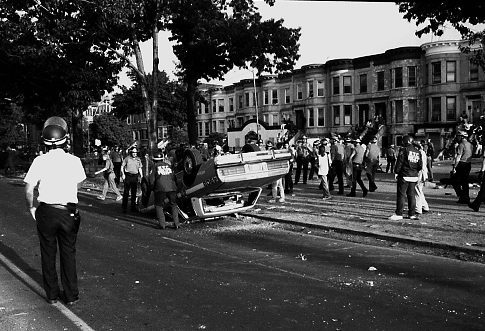20 Years of Misreporting the Crown Heights Riot

Twenty years ago this week rioting broke out in Brooklyn's Crown Heights section. Ari L. Goldman, a Professor at Columbia University's School of Journalism, was part of the team of reporters covering the riots for the New York Times. His riveting account of his experience has just appeared New York's Jewish Week.
In 1991, reporters could not yet file stories directly by laptop or smart phones. Goldman phoned in his accounts of what he saw in the streets to the newspaper, where they were transcribed and then shaped into stories by rewrite reporters and editors. But what appeared in the paper did not reflect his reporting. The headlines and stories portrayed the riots solely in terms of clashes between blacks and Hassidic Jews, instead of anti-Semitic violence.
One 'lead' to a Times story Goldman says was simply untrue. "Hassidim and blacks clashed in the Crown Heights section of Brooklyn through the day and to the night yesterday," it read. But Goldman never saw -- or heard of -- any instances of Jews attacking blacks.
Although outraged, Goldman, as a loyal Times employee, at first deferred to his editors. But on the third day of the riots, he found himself standing among a group of Hassidic men that were attacked with rocks and bottles by a group of demonstrators who had come down the street chanting 'Heil Hitler,' and 'Death to the Jews."
Goldman immediately phoned his editor, speaking to him angrily, in a way that he has never had addressed a boss before or since:
You don't know what's happening here! I am on the streets getting attacked. ... (W)hat comes out in the paper? 'Hasidim and blacks clashed'? That's not what's happening here. Jews are being attacked! You've got this story wrong.
Goldman insists that the editors -- not the rewrite reporters -- were responsible for distorting his dispatches. "It was clear to me that they had settled on a 'frame' for the story. The way they saw it, there were narratives here, the white narrative and black narrative. And both had equal weight."
Times editorials echoed the new stories: "The violence following an auto accident in Crown Heights reminds all New Yorker's that the city's race relations remain dangerously strained."
Responding to e-mail questions from FrumForum, Goldman refused to attribute shortcomings in the Times's coverage to deliberate bias. "I think that the Times was reaching too hard for balance and this led to a distortion of what was really happening. I don't think that there was a bias for or against Jews or blacks. If anything there was a bias for balance -- which is a good impulse -- but was ultimately not enough to tell a complex story."
This explanation is unconvincing. When does suppressing a major element of a story -- in this case black anti-Semitism -- ever advance good or balanced journalism?
Goldman emphatically asserted to FrumForum that the Times coverage of Crown Heights was an independent incident and should not been as emblematic of how the paper covers anything else.
Yet the problems with the Times coverage of the Crown Heights riots seem to be examples of flaws with an institutional culture. Too often people are arbitrarily in groups of victims and victimizers, with everything done by perceived victimizers being portrayed as villainous while the misdeeds of the perceived victims often overlooked.
For instance, the Crown Heights crisis was one of a number instances when the rhetoric of Reverend Al Sharpton played an incendiary role. The bloodiest of these occurred during demonstrations in front of a Harlem department store, Freddy's. He called the store's owners "white interlopers". This led to a black militant torching the white-owned store and shooting seven people to death -- including himself.
Yet, according to William McGowan, the author of a critical profile of the Times, Gray Paper Down, "no matter what sins he has committed against the civic fabric," the newspaper has often "rehabilitated" Sharpton. During the Freddy's crisis The Times ran a story in which Sharpton was characterized as a "consoler, conciliator, and political jouster". Sharpton was even given the opportunity to play the role of victim. "In my life, I have had to walk alone sometimes ... I've been lied on, talked about, mistreated, stabbed and indicted. But through it all I've learned to trust in Jesus, and trust in God. It's only a test." This treatment has allowed Sharpton to emerge as one of the leaders of the New York black community, the Democratic Party, and now a MSNBC host.
The biases that produced the distortions in the Crown Heights coverage still exist. FBI bias incidents provide a good measure of the intensity of animosity against different groups in the US and in 2009, there were only 108 reported anti-Islamic hate incidents while the number of anti-Jewish incidents was 8 times greater. The number of anti-Jewish incidents have dwarfed the number of anti-Islamic incidents in every year since 2001.

